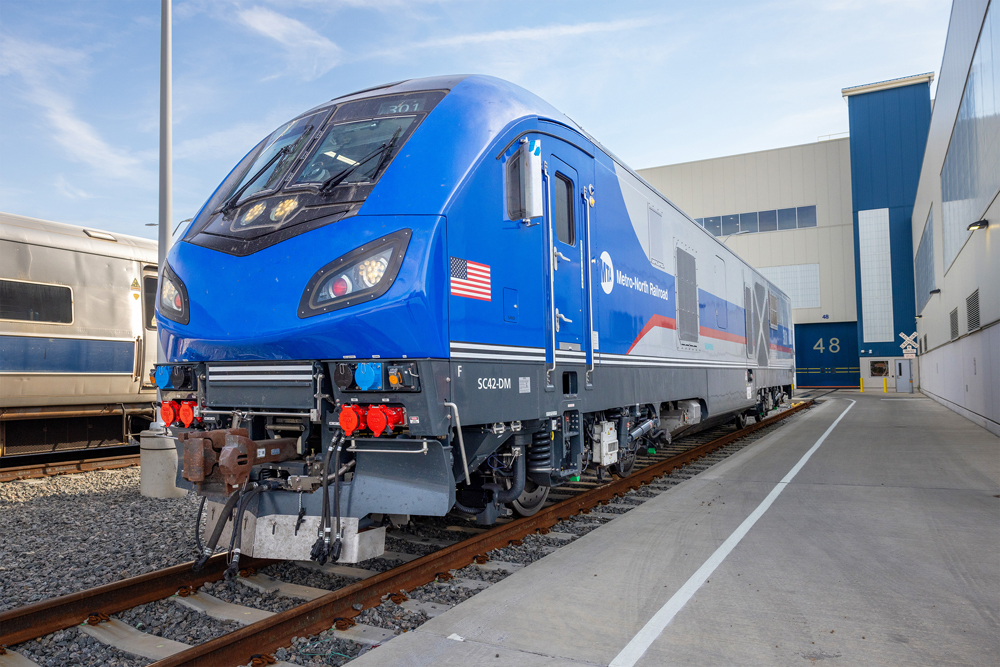“We’re not in the market at all for new locomotives,” Creel told an investor conference on Wednesday. The railroad’s not likely to buy new until 2021 or 2022, he says.
CP stored more than 600 locomotives between 2012 and 2016, when former CEO E. Hunter Harrison implemented his Precision Scheduled Railroading operating model.
CP moves tonnage on fewer, longer trains, which allows it to rely on a smaller active locomotive fleet despite handling more traffic.
CP has been sending AC units out for modernization, with the fleet expansion necessary to handle increased international intermodal and crude oil traffic. CP’s volume is up 10 percent this year when measured by revenue ton-miles.
The railroad took delivery of 80 modernized AC4400s from General Electric this year, and is scheduled to receive 30 upgraded SD90MACs next year as SD70ACU locomotives from Progress Rail.
Creel says CP favors rebuilding older high-horsepower units for two reasons: It’s cheaper, and a modernized older locomotive is more reliable than a new locomotive that’s compliant with U.S. Tier IV emissions requirements.
CP is rebuilding units for a little less than $2 million each, while a new GE comes with a sticker price of around $3 million, Creel says.
New locomotives are less reliable than a remanufactured unit, Creel says. Until manufacturers work out the bugs and reliability matches older units, CP is not interested in buying new, he says.
The railroad does have options on short-term locomotive leases if traffic rises faster than expected, Chief Financial Officer Nadeem Velani says.
It’s unlikely that CP would grab surplus locomotives that are being retired at CSX Transportation and Union Pacific as both railroads implement their scheduled railroading operating models.
CP’s entire road fleet is AC-traction and capable of running in distributed power mode — something that’s not common as Class I railroads purge their rosters of older DC-traction units.
Creel spoke at the Credit Suisse Industrials Conference.















As for losing customers, the railroads are their own worst enemy. Because they have some customes captive, they tend to ignore their customers’ concerns. Railroading is a world unto itself, which can be hard to see from outside. Chasing operating ratio at the expense of everything else is one of the symptoms.
JF Turcotte says “No need for new locomotives when your plan is to go out-of-business by de-marketing your own services. “. CP says “CP’s volume is up 10 percent this year when measured by revenue ton-miles.”. Sounds like “de-marketing” is a success!
Agree that going the specific emissions route with Tier 4 instead of allowing other solutions for non-compliant urban areas such as mother/slug sets, reduced idling/shutdown, etc. was a mistake. A little bit of extra NOx in the middle of rural US isn’t a very big problem.
The freight RRs choosing the no DEF route also looks like a mistake. The RRs didn’t want to have to invest in the equipment to store and deliver DEF, nor the expense of purchase. That appears to be short sighted, now. The complexity needed to get to Tier 4 reduces the fuel efficiency and reliability of new locomotives. The only way forward now is to keep buying and work with the builders to make improvements.
What I can not understand is why railroads are not using DEF for emissions compliance. For trucking it has been considerably more reliable and better fuel economy.
Will there be any locomotive builders left to build them by 2021? If you don’t keep your suppliers healthy, the won’t be there when you need them.
Decades ago, the RRs would often buy at least some of their fleet from GE, just to keep them alive and to keep EMD on their toes. The GE locomotives were almost always a poorer investment than the EMDs, yet the RRs kept GE in the game.
If every road decides to stop purchasing for a few years because of PSR or economic downturn or whatever, that may just kill domestic locomotive manufacturing.
Now if they only had the crews to move the trains.
New is less reliable than old? What the flip, I guess I won’t be in the market for a new refrigerator this year, after all. Maybe I’ll see what I can find on Craigslist or yard sales.
It would be interesting to know if the unreliability of Tier 4 units is based on fact or perception. I do think most tier 4 diesel engines, except locomotives, get better fuel economy and produce less carbon emissions than tier 3 engines. The refusal of the rail industry to go to a urea after treatment system should at least theoretically hurt the fuel efficiency of tier 4 locomotives.
No need for new locomotives when your plan is to go out-of-business by de-marketing your own services.
….maybe a smoke screen while merger talks go on – you think maybe ??
I’m not knee-jerk anti-regulation by any means and I value sane environmental protection. But there’s a lot of misguided environmental regulation that fails to take the bigger picture into account.
I think Tier IV is an example of the latter It’s at best high cost for diminishing returns (in the form of NOx reductions) and at worst damages the ability for rail to compete with trucking due to poorer reliability and higher cost. And yes as Mr. Oltmann points out is also a direct threat to the viability of the domestic locomotive industry.
And while I don’t condone unethical cheating, I strongly suspect the Volkswagen and now Daimler emissions scandals actually penalize a more powerful AND more fuel efficient (thus less carbon emission producing) engine technology in order to achieve costly NOx emission reductions that don’t produce a significant environmental benefit.
This hearkens to an era when Southern Railway did not order new steam locomotives after the 1920’s. It was 1939 when Southern started purchasing new EMC FT diesel-electric locomotives for freight trains and in 1941, Alco DL109’s and EMC E6’s for certain passenger trains, including “The Crescent” , “The Southerner” and “The Tennessean”.
Southern Railway was frugal with purchasing new equipment unlike Santa Fe, the Pennsylvania Railroad, Union Pacific Railroad and the Burlington Line. It purchases focused on improving efficiency, being the first railway to fully dieselise. And, only four of its passenger trains were designated streamliners, “The Southerner” and “The Tennessean” in 1941 and then “The Crescent” and “The New Royal Palm” in 1949 and 1950.
James F Shigley,
Creels comment about the Tier IV locomotives is not based on any facts that I’m aware of, it sounds purely like a cover up to not have to deal with the UNITED STATES requirement for Tier IV emissions standards.
Creel’s comment that new Tier IV are less reliable than rebuilt locomotives is very telling.